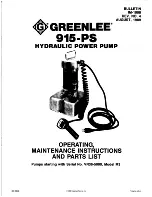
Page 31
P O W E R I N G T E C H N O L O G Y
Document No. M00035-MAN rev. 3a
aspiro1u_m35-man-rev3a-0417.indd
5.5 Test of output voltage
5.5.1 Float charge (U1)
Ensure that the controller is operating.
Connect a load, approx. 50% of total capacity, to the system.
Check the voltage according to the battery manufacturer’s requirements. If the batteries
require a different float charging voltage, adjust the output voltage from the controller. (See
the section for the appropriate controller)
If no change is required, use the following values:
Battery type
Float charge Boost charge
Open lead-acid batteries
2.23 V/Cell
2.33 V/Cell
Valve regulated lead-acid batteries 2.27 V/Cell
-
Table 5-1 Float/Boost Charge Voltages
5.5.2 Adjustment of Float Charge, U1
Unless otherwise ordered the default output voltage is factory pre-set to 53.5V. The total
voltage has to be in accordance to the number of battery cells.
Please verify number of cells and the battery manufacturers requirement.
Adjust the output voltage from the control unit as necessary.
NOTE
A seal protects the potentiometer in the subrack. Do not break the seal.
5.5.3 Boost charging (U2) (if applicable)
Open lead-acid batteries.
Automatic boost charging - calculation based on the time the battery voltage has been below
certain levels. Automatic activating of boost charging for this calculated time multiplied by
a (boost) factor.
Activate boost charging from the “Set/select U1-U4” menu in the controller.
Return to float charge manually by selecting “U1”, or automatically after a pre-set time.
VRLA batteries.
Most of the manufactures of valve regulated lead acid batteries
do not recommend
boost
charging. If this type of battery is used, the boost function should be disabled.














































